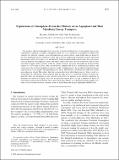Explorations of Atmosphere–Ocean–Ice Climates on an Aquaplanet and Their Meridional Energy Transports
Author(s)
Enderton, Daniel; Marshall, John C
DownloadEnderton-2009-Explorations of Atmo.pdf (4.089Mb)
PUBLISHER_POLICY
Publisher Policy
Article is made available in accordance with the publisher's policy and may be subject to US copyright law. Please refer to the publisher's site for terms of use.
Terms of use
Metadata
Show full item recordAbstract
The degree to which total meridional heat transport is sensitive to the details of its atmospheric and oceanic components is explored. A coupled atmosphere, ocean, and sea ice model of an aquaplanet is employed to simulate very different climates—some with polar ice caps, some without—even though they are driven by the same incoming solar flux. Differences arise due to varying geometrical constraints on ocean circulation influencing its ability to transport heat meridionally. Without complex land configurations, the results prove easier to diagnose and compare to theory and simple models and, hence, provide a useful test bed for ideas about heat transport and its partition within the climate system. In particular, the results are discussed in the context of a 1978 study by Stone, who argued that for a planet with Earth’s astronomical parameters and rotation rate, the total meridional heat transport would be independent of the detailed dynamical processes responsible for that transport and depend primarily on the distribution of incoming solar radiation and the mean planetary albedo. The authors find that in warm climates in which there is no ice, Stone’s result is a useful guide. In cold climates with significant polar ice caps, however, meridional gradients in albedo significantly affect the absorption of solar radiation and need to be included in any detailed calculation or discussion of total heat transport. Since the meridional extent of polar ice caps is sensitive to details of atmospheric and oceanic circulation, these cannot be ignored. Finally, what has been learned is applied to a study of the total heat transport estimated from the Earth Radiation Budget Experiment (ERBE) data.
Date issued
2008-07Department
Massachusetts Institute of Technology. Department of Earth, Atmospheric, and Planetary Sciences; MIT Energy InitiativeJournal
Journal of the Atmospheric Sciences
Publisher
American Meteorological Society
Citation
Enderton, Daniel, and John Marshall. “Explorations of Atmosphere–Ocean–Ice Climates on an Aquaplanet and Their Meridional Energy Transports.” Journal of the Atmospheric Sciences (2009): 1593-1611. © 2010 American Meteorological Society
Version: Final published version
ISSN
0022-4928